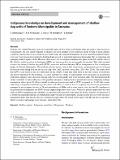| dc.description.abstract | In this paper we explore the emergence and functioning of river committees (RCs) in Tanzania, which
are local water management structures that allocate and solve water conflict between different water users
(smallholder irrigators, large commercial farmers, municipalities, etc) along one river. The paper is based on
empirical research of three committees in the Themi sub-catchment. The committees mostly emerged in response
to drought-induced competition and conflict over water, rapid urbanisation around Arusha town, and the
presence of markets for agricultural produce. The RCs are mainly active during dry seasons when water is scarce.
We find that the emergence of the RCs can be understood by using the concept of institutional bricolage. We then
assess their effective functioning with the help of the eight design principles proposed by Ostrom and find that
the best performing RC largely complied with five of them, which indicates that not all principles are necessary for
a water institution to be effective and to endure over time. The other two studied RCs complied with only three of
these principles. All RCs leave the resource boundary open to negotiation, which lowers the transaction cost of
controlling the boundaries and also allows future demands to be met in the face of increasing resource variability.
All RCs do not fully comply with the principle that all affected must take part in rule creation and modification. In
all three cases, finally, the 'nesting' of lower-level institutional arrangements within higher-level ones is
inconsistent.
To explain the difference in the performance of the three RCs we need to consider factors related to
heterogeneity. We find that the functioning of RCs is strongly influenced by group size, spatial distance,
heterogeneity of users and uses, and market forces. | en_US |

